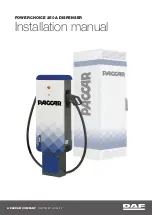
flammable material. Contact a qualified spe-
cialist workshop immediately if damage is
detected.
!
There is a risk of damage to the vehicle if:
R
the vehicle becomes stuck, e.g. on a high
curb or an unpaved road
R
you drive too fast over an obstacle, e.g. a
curb, a speed bump or a pothole in the road
R
a heavy object strikes the underbody or
parts of the chassis
In situations like this, the body, the under-
body, chassis parts, wheels or tires could be
damaged without the damage being visible.
Components damaged in this way can unex-
pectedly fail or, in the case of an accident, no
longer withstand the loads they are designed
to.
If the underbody paneling is damaged, com-
bustible materials such as leaves, grass or
twigs can gather between the underbody and
the underbody paneling. If these materials
come in contact with hot parts of the exhaust
system, they can catch fire.
In such situations, have the vehicle checked
and repaired immediately at a qualified spe-
cialist workshop. If on continuing your jour-
ney you notice that driving safety is impaired,
pull over and stop the vehicle immediately,
paying attention to road and traffic condi-
tions. In such cases, consult a qualified spe-
cialist workshop.
The vehicle is only designed for easily negotiable
off-road terrain and poor road surfaces.
When driving off-road, substances such as sand,
mud and water or water mixed with oil may get
into the brakes. This could result in a reduced
braking effect or in total brake failure and also in
increased wear and tear. The braking charac-
teristics change depending on the material
entering the brakes. Clean the brakes after driv-
ing off-road. If you detect a reduced braking
effect or grinding noises, have the brake system
checked in a qualified specialist workshop as
soon as possible. Adapt your driving style to the
different braking characteristics.
Driving off-road increases the likelihood of dam-
age to the vehicle, which, in turn, can lead to
failure of the mechanical assembly or systems.
Adapt your driving style to suit the terrain con-
ditions. Drive carefully. Have damage to the
vehicle rectified immediately at a qualified spe-
cialist workshop.
Do not shift into transmission position
i
when
driving off-road. You could lose control of the
vehicle if you attempt to brake the vehicle using
the service brake. If the gradient is too steep for
your vehicle, drive back down in reverse gear.
General notes
H
Environmental note
Protection of the environment is of primary
importance. Treat nature with respect.
Observe all prohibiting signs.
Read this section carefully before driving your
vehicle off-road.
Off-road driving is only possible with the Off-
Road Engineering package (
Y
page 181).
The following driving systems are specially
adapted for driving over easily negotiable off-
road terrain:
R
Off-road program (
Y
page 181)
R
Off-road 4ETS (
Y
page 70)
R
Off-road ESP
®
(
Y
page 72)
R
DSR (Downhill Speed Regulation)
(
Y
page 180)
Observe the following notes:
R
Stop the vehicle before starting to drive along
an off-road route. If necessary, activate the
off-road program (
Y
page 181).
R
To avoid damaging the vehicle, make sure
there is always sufficient ground clearance.
R
Check that items of luggage and loads are
stowed safely and are well secured
(
Y
page 295).
R
Always keep the engine running and in gear
when driving on a downhill gradient. Activate
DSR (
Y
page 180).
R
Drive slowly and evenly, if necessary at a
walking pace.
R
Ensure that the wheels are in contact with the
ground at all times.
R
Drive with extreme care on unfamiliar off-road
routes where visibility is poor. For safety rea-
sons, get out of the vehicle first and survey
the off-road route.
R
Check the depth of water before fording rivers
and streams.
R
Watch out for obstacles.
166
Driving tips
Driv
ing
and
parking
Содержание GLC
Страница 28: ...Workshop see Qualified specialist workshop 26 Index ...
Страница 388: ...386 ...
Страница 389: ...387 ...
Страница 390: ...388 ...
















































